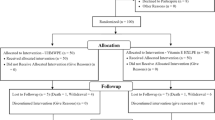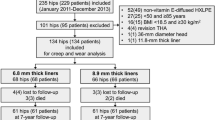Abstract
Background
Progressive oxidation of highly cross-linked ultra-high molecular weight (UHMPWE-X) liners is considered to be a risk factor for material failure in THA. Antioxidants such as vitamin E (alpha-tocopherol) (UHMWPE-XE) were supplemented into the latest generation of polyethylene liners. To prevent inhomogenous vitamin E distribution within the polymer, blending was established as an alternative manufacturing process to diffusion. The purpose of the present study was to investigate the in vivo wear behavior of UHMWPE-XE in comparison with conventional UHMWPE-X liners using virtual CAD-based radiographs.
Methods
Until now, 94 patients from a prospective, randomized, controlled, multicenter study were reviewed at 5-year follow-up. Of these, 51 (54%) received UHMWPE-XE and 43 (46%) UHMWPE-X liners. Anteroposterior pelvic radiographs were made immediately after surgery and at 1 and 5 years postoperatively. The radiographs were analyzed using the observer-independent analysis software RayMatch® (Raylytic GmbH, Leipzig, Germany).
Results
The mean wear rate was measured to be 23.6 μm/year (SD 13.7; range 0.7–71.8 μm). There were no significant differences between the two cohorts (UHMWPE-X: 23.2 μm/year vs. UHMWPE-XE: 24.0 μm/year, p = 0.73). Cup anteversion significantly changed within the 1st year after implantation independent from the type of polyethylene liner [UHMWPE-X: 18.2–23.9° (p = 0.0001); UHMWPE-XE: 21.0–25.5° (p = 0.002)]. No further significant changes of cup anteversion in both groups were found between year 1 and 5 after implantation [UHMWPE-X (p = 0.46); UHMWPE-XE (p = 0.56)].
Conclusion
The present study demonstrates that the addition of vitamin E does not adversely affect the midterm wear behavior of UHMWPE-X. The antioxidative benefit of vitamin E is expected to become evident in long-term follow-up. Cup anteversion increment by 5° within the 1st year is likely a result of the released hip flexion contracture resulting in an enhanced posterior pelvic tilt. Therefore, a reassessment of target values in acetabular cup placement might be considered.


Similar content being viewed by others
Availability of data and materials
All patient-related data were collected by file research from the archives of the participating centers.
References
Beaulé PE, Campbell P, Mirra J, Hooper JC, Schmalzried TP (2001) Osteolysis in a cementless, second generation metal-on-metal hip replacement. Clin Orthop Relat Res 386:159–165
Muratoglu OK, Kurtz S (2002) Alternate bearing surfaces in hip replacement. In: Sinha R (ed) Hip replacement. Current trends and controversies. CRC Press, New York, pp 1–46
Oral E, Wannomae KK, Rowell SL, Muratoglu OK (2007) Diffusion of vitamin E in ultra-high molecular weight polyethylene. Biomaterials 28(35):5225–5237 (Epub 2007 Sep 19)
Kawakage NOS, Ogihara T (1997) Poly (vinyl alcohol)-clay and poly (ethylene oxide)-clay blends prepared using water as solvent. J Appl Polym Sci 66:573–581
Digas G, Karrholm J, Thanner J, Malchau H, Herberts P (2004) Highly cross-linked polyethylene in total hip arthroplasty: randomized evaluation of penetration rate in cemented and uncemented sockets using radiostereometric analysis. Clin Orthop. 429:16
Nivbrant B, Roerhl S, Hewitt B, Li M. In vivo wear and migration of high cross linked poly cups: a RSA study. In: 49th Annual Orthopaedic Research Society; 2003; New Orleans; 2003. p. 358
MacDonald D, Sakona A, Ianuzzi A et al (2011) Do first-generation highly crosslinked polyethylenes oxidize in vivo? Clin Orthop Relat Res 469:2278–2285
Oral E, Christensen S, Malhi A, Wannomae K, Muratoglu O (2006) Wear resistance and mechanical properties of highly crosslinked UHMWPE doped with vitamin E. J Arthroplasty 21(4):580–591
Bracco P, Oral E (2011) Vitamin E-stabilized UHMWPE for total joint implants: a review. Clin Orthop Relat Res 469:2286–2293
Oral E, Wannomae KK, Hawkins N, Harris WH, Muratoglu OK (2004) Tocopheroldoped irradiated UHMWPE for high fatigue resistance and low wear. Biomaterials 25:5515–5522
Grupp TM, Holderied M, Mulliez MA, Streller R, Jäger M, Blömer W, Utzschneider S (2014) Biotribology of a vitamin E-stabilized polyethylene for hip arthroplasty—influence of artificial ageing and third-body particles on wear. Acta Biomater 10(7):3068–3078. https://doi.org/10.1016/j.actbio.2014.02.052(Epub 2014 Mar 12)
Oral E, Godleski Beckos C, Malhi AS, Muratoglu OK (2008) The effects of high dose irradiation on the cross-linking of vitamin E-blended ultrahigh molecular weight polyethylene. Biomaterials 29(26):3557–3560. https://doi.org/10.1016/j.biomaterials.2008.05.004(Epub 2008 Jun 2)
Xu JZ, Wannomae KK, Muratoglu OK, Oral E (2018) Increased oxidative protection by high active vitamin E content and partial radiation crosslinking of UHMWPE. J Orthop Res 36(7):1860–1867. https://doi.org/10.1002/jor.23835(Epub 2018 Jan 3)
Oral E, Ghali BW, Rowell SL, Micheli BR, Lozynsky AJ, Muratoglu OK (2010) A surface crosslinked UHMWPE stabilized by vitamin E with low wear and high fatigue strength. Biomaterials 31(27):7051–7060. https://doi.org/10.1016/j.biomaterials.2010.05.041(Epub 2010 Jun 25)
Oral E, Muratoglu OK (2011) Vitamin E diffused, highly crosslinked UHMWPE: a review. Int Orthop 35(2):215–223. https://doi.org/10.1007/s00264-010-1161-y(Epub 2010 Dec 1)
Parth M, Aust N, Lederer K (2002) Studies on the effect of electron beam radiation on the molecular structure of ultra-high molecular weight polyethylene under the influence of alpha-tocopherol with respect to its application in medical implants. J Mater Sci Mater Med 13(10):917–921
Oral E, Greenbaum E, Malhi A, Muratoglu O (2005) Characterization of blends of α-Tocopherol with UHMWPE. Biomaterials 26:6657–6663
Oral E, Neils AL, Rowell SL, Lozynsky AJ, Muratoglu OK (2013) Increasing irradiation temperature maximizes vitamin E grafting and wear resistance of ultrahigh molecular weight polyethylene. J Biomed Mater Res B Appl Biomater 101(3):436–440. https://doi.org/10.1002/jbm.b.32807(Epub 2012 Oct 31)
Ayers DC, Greene M, Snyder B et al (2015) Radiostereometric analysis study of tantalum compared with titanium acetabular cups and highly cross-linked compared with conventional liners in young patients undergoing total hip replacement. J Bone Joint Surg Am 97:627–634
Selvik G (1989) Roentgen stereophotogrammetry. A method for the study of the kinematics of the skeletal system. Acta Orthop Scand 232:1–51
Bottner F, Su E, Nestor B, Azzis B, Sculco TP, Bostrom M (2005) Radiostereometric analysis: the hip. HSS J. 1(1):94–99. https://doi.org/10.1007/s11420-005-0114-2
Stilling M, Kold S, de Raedt S, Andersen NT, Rahbek O, Søballe K (2012) Superior accuracy of model-based radiostereometric analysis for measurement of polyethylene wear: a phantom study. Bone Joint Res. 1(8):180–191. https://doi.org/10.1302/2046-3758.18.2000041(Print 2012 Aug)
Troelsen A, Greene ME, Ayers DC, Bragdon CR, Malchau H (2015) A Novel method for assessment of polyethylene liner wear in radiopaque tantalum acetabular cups: clinical validation in patients enrolled in a randomized controlled trial. J Arthroplasty 30(12):2354–2359. https://doi.org/10.1016/j.arth.2015.06.050(Epub 2015 Jul 2)
Langton DJ, Sprowson AP, Mahadeva D, Bhatnagar S, Holland JP, Nargol AV (2010) Cup anteversion in hip resurfacing: validation of EBRA and the presentation of a simple clinical grading system. J Arthroplasty 25(4):607–613. https://doi.org/10.1016/j.arth.2009.08.020(Epub 2009 Dec 21)
Biedermann R, Krismer M, Stöckl B, Mayrhofer P, Ornstein E, Franzén H (1999) Accuracy of EBRA-FCA in the measurement of migration of femoral components of total hip replacement. Einzel-Bild-Röntgen-Analyse-femoral component analysis. J Bone Joint Surg Br. 81(2):266–272
Krismer M, Bauer R, Tschupik J, Mayrhofer P (1995) EBRA: a method to measure migration of acetabular components. J Biomech 28(10):1225–1236
Callary SA, Solomon LB, Holubowycz OT et al (2017) Accuracy of methods to measure femoral head penetration within metal-backed acetabular components. J Orthop Res 35:988–996
Haversath M, Klebingat S, die VITAS-Gruppe, Jäger M (2018) Endoprosthetic wear analysis using virtual CAD-based radiographs. Orthopade. 47(10):811–819. https://doi.org/10.1007/s00132-018-3602-z(Article in German)
Jäger M, Van Wasen A, Warwas S et al (2014) A multicenter approach evaluating the impact of vitamin e-blended polyethylene in cementless total hip replacement. Orthop Rev (Pavia) 6:5285
Dowd JE, Sychterz CJ, Young AM, Engh CA (2000) Characterization of long-term femoral-head-penetration rates. Association with and prediction of osteolysis. J Bone Joint Surg Am. 82(8):1102–1107
Scemama C, Anract P, Dumaine V, Babinet A, Courpied JP, Hamadouche M (2017) Does vitamin E-blended polyethylene reduce wear in primary total hip arthroplasty: a blinded randomised clinical trial. Int Orthop 41(6):1113–1118. https://doi.org/10.1007/s00264-016-3320-2(Epub 2016 Nov 4)
Salemyr M, Muren O, Ahl T, Bodén H, Chammout G, Stark A, Sköldenberg O (2015) Vitamin-E diffused highly cross-linked polyethylene liner compared to standard liners in total hip arthroplasty. A randomized, controlled trial. Int Orthop. 39(8):1499–1505. https://doi.org/10.1007/s00264-015-2680-3(Epub 2015 Jan 29)
Nebergall AK, Greene ME, Laursen MB, Nielsen PT, Malchau H, Troelsen A (2017) Vitamin E diffused highly cross-linked polyethylene in total hip arthroplasty at five years: a randomised controlled trial using radiostereometric analysis. Bone Joint J. 99(5):577–584. https://doi.org/10.1302/0301-620x.99b5.37521
Galea VP, Connelly JW, Shareghi B, Kärrholm J, Sköldenberg O, Salemyr M, Laursen MB, Muratoglu O, Bragdon C, Malchau H (2018) Evaluation of in vivo wear of vitamin E-diffused highly crosslinked polyethylene at five years: a multicentre radiostereometric analysis study. Bone Joint J. 100(12):1592–1599. https://doi.org/10.1302/0301-620x.100b12.bjj-2018-0371.r1
Shareghi B, Johanson PE, Kärrholm J (2017) Wear of vitamin E-infused highly cross-linked polyethylene at five years. J Bone Joint Surg Am 99(17):1447–1452. https://doi.org/10.2106/JBJS.16.00691
Sillesen NH, Greene ME, Nebergall AK, Huddleston JI, Emerson R, Gebuhr P, Troelsen A, Malchau H (2016) 3-year follow-up of a long-term registry-based multicentre study on vitamin E diffused polyethylene in total hip replacement. Hip Int. 26(1):97–103. https://doi.org/10.5301/hipint.5000297(Epub 2015 Dec 11)
Beckmann NA, Jaeger S, Janoszka MB, Klotz MC, Bruckner T, Bitsch RG (2018) Comparison of the primary stability of a porous coated acetabular revision cup with a standard cup. J Arthroplasty 33(2):580–585. https://doi.org/10.1016/j.arth.2017.09.023(Epub 2017 Sep 20)
O’Rourke D, Al-Dirini RM, Taylor M (2018) Primary stability of a cementless acetabular cup in a cohort of patient-specific finite element models. J Orthop Res 36(3):1012–1023. https://doi.org/10.1002/jor.23709(Epub 2017 Sep 12)
Saka G, Altun G, Burc H, Aydogan M (2019) A new radiographic acetabular cup anteversion measurement method in total hip arthroplasty: a clinical study. Eur J Orthop Surg Traumatol. https://doi.org/10.1007/s00590-019-02384-9(Epub ahead of print)
Muir JM, Vincent J, Schipper J, Govindarajan M, Paprosky WG (2018) Evaluation of tilt-correction of anteversion on anteroposterior pelvic radiographs in total hip arthroplasty. Cureus 10(5):e2647. https://doi.org/10.7759/cureus.2647
Tiberi JV III, Antoci V, Malchau H, Rubash HE, Freiberg AA, Kwon YM (2015) What is the fate of total hip arthroplasty (THA) acetabular component orientation when evaluated in the standing position? J Arthroplasty 30:1555–1560
Hassan DM, Johnston GH, Dust WN, Watson LG, Cassidy D (1995) Radiographic calculation of anteversion in acetabular prostheses. J Arthroplasty 10:369–372
Sillesen NH, Greene ME, Nebergall AK, Nielsen PT, Laursen MB, Troelsen A, Malchau H (2015) Three year RSA evaluation of vitamin E diffused highly cross-linked polyethylene liners and cup stability. J Arthroplasty 30:1260–1264
Funding
The study is financially supported by B. Braun-Aesculap AG, Germany; Trial registration: NCT01713062. This study was supported by B. Braun Melsungen (AAG-G-H-1113).
Author information
Authors and Affiliations
Consortia
Contributions
All authors ensured that they had furnished a substantial contribution to the article and that they are in agreement with form and contents of the manuscript.
Corresponding author
Ethics declarations
Ethics approval and consent to participate
The study was approved by the local ethics committee (11-4845-BO). The study was registered on Clinicaltrials.gov. The trial registration number is NCT01713062.
Consent to publish
All patients consented to publish personal data in an anonymised form.
Conflict of interest
The authors declare they have no conflict of interest.
Patient confidentiality
Data were protected according to the U.S. Health Insurance Portability and Accountability Act (HIPAA).
Additional information
Publisher's Note
Springer Nature remains neutral with regard to jurisdictional claims in published maps and institutional affiliations.
Rights and permissions
About this article
Cite this article
Busch, A., Jäger, M., Klebingat, S. et al. Vitamin E-blended highly cross-linked polyethylene liners in total hip arthroplasty: a randomized, multicenter trial using virtual CAD-based wear analysis at 5-year follow-up. Arch Orthop Trauma Surg 140, 1859–1866 (2020). https://doi.org/10.1007/s00402-020-03358-x
Received:
Published:
Issue Date:
DOI: https://doi.org/10.1007/s00402-020-03358-x




